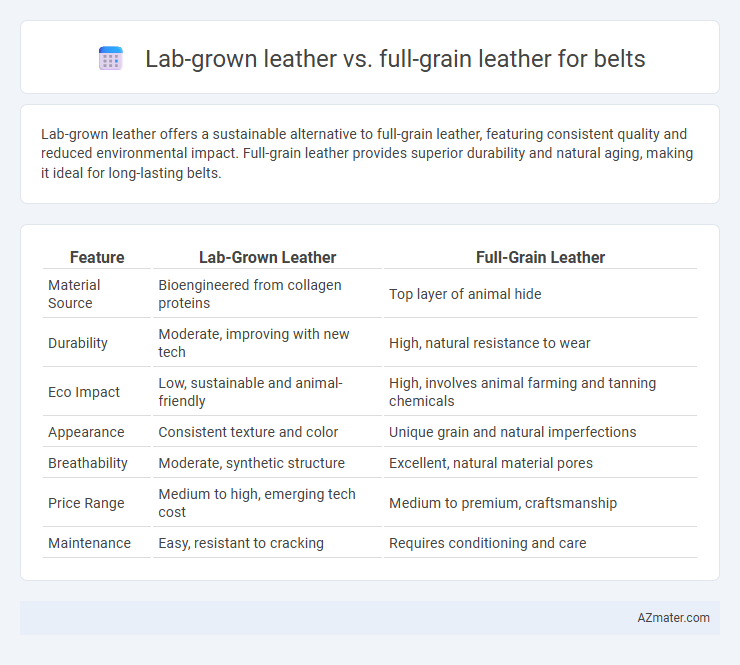Lab-grown leather offers a sustainable alternative to full-grain leather, featuring consistent quality and reduced environmental impact. Full-grain leather provides superior durability and natural aging, making it ideal for long-lasting belts.
Table of Comparison
| Feature | Lab-Grown Leather | Full-Grain Leather |
|---|---|---|
| Material Source | Bioengineered from collagen proteins | Top layer of animal hide |
| Durability | Moderate, improving with new tech | High, natural resistance to wear |
| Eco Impact | Low, sustainable and animal-friendly | High, involves animal farming and tanning chemicals |
| Appearance | Consistent texture and color | Unique grain and natural imperfections |
| Breathability | Moderate, synthetic structure | Excellent, natural material pores |
| Price Range | Medium to high, emerging tech cost | Medium to premium, craftsmanship |
| Maintenance | Easy, resistant to cracking | Requires conditioning and care |
Introduction to Lab-Grown Leather vs Full-Grain Leather
Lab-grown leather, created through biofabrication techniques using cultured animal cells, offers a sustainable and cruelty-free alternative to traditional hides. Full-grain leather, derived from the outermost layer of animal skin, is renowned for its durability, natural texture, and aging qualities, making it a premium choice for belts. The key differences lie in environmental impact, production methods, and material characteristics, influencing consumer preference in the leather goods market.
What Is Lab-Grown Leather?
Lab-grown leather is an innovative material created by cultivating animal cells in a controlled environment to produce leather without traditional animal farming. This biofabricated leather offers sustainable advantages such as reduced environmental impact, lower water usage, and no animal slaughter. In contrast to full-grain leather, which is made from the top layer of animal hides and prized for its durability and natural texture, lab-grown leather provides an eco-friendly alternative while maintaining similar aesthetic and functional qualities for belt production.
What Is Full-Grain Leather?
Full-grain leather is the highest quality leather, made from the top layer of the animal hide, retaining its natural grain and strength. Known for its durability, breathability, and ability to develop a rich patina over time, it is highly prized for belts that require long-lasting wear and aesthetic appeal. Unlike lab-grown leather, full-grain leather provides authentic texture and unique markings that enhance its character and value.
Sustainability and Environmental Impact
Lab-grown leather offers a sustainable alternative to traditional full-grain leather by significantly reducing water consumption and greenhouse gas emissions associated with cattle farming. Full-grain leather production often involves extensive land use, chemical tanning processes, and deforestation, contributing to higher environmental degradation. Choosing lab-grown leather for belts supports circular fashion practices, minimizes animal agriculture's carbon footprint, and decreases reliance on toxic tanning chemicals.
Durability and Longevity
Lab-grown leather offers consistent durability due to its controlled manufacturing process, making it resistant to cracking and stretching over time. Full-grain leather, renowned for its natural toughness and ability to develop a rich patina, provides exceptional longevity when properly maintained. Both materials excel in belt durability, but full-grain leather's unique aging process often results in a more personalized and long-lasting accessory.
Appearance and Texture Comparison
Lab-grown leather offers a consistent surface texture with uniform grain patterns, mimicking traditional leather while allowing customizable finishes ranging from smooth to pebbled. Full-grain leather displays natural imperfections and unique markings, providing a rich, authentic appearance with a supple texture that softens over time. The tactile experience of full-grain leather is often preferred for belts due to its durability and the development of a distinctive patina not achievable with lab-grown alternatives.
Comfort and Wearability
Lab-grown leather offers enhanced comfort due to its consistent texture and flexibility, reducing stiffness often found in full-grain leather belts. Full-grain leather, known for its durability and natural breathability, molds to the wearer over time, providing personalized comfort and superior wearability. Both materials balance comfort and longevity, but lab-grown leather excels in uniform softness while full-grain leather delivers a timeless, robust feel.
Price and Cost Analysis
Lab-grown leather typically costs 20-40% more than full-grain leather due to advanced bio-fabrication techniques and limited production scale. Full-grain leather, harvested from the top layer of animal hides, offers durability and a natural patina, often providing a better cost-to-longevity ratio for belts. Price-sensitive consumers may prefer full-grain leather for its affordability and proven wear resistance, while lab-grown leather appeals to eco-conscious buyers willing to invest in innovative materials despite higher prices.
Ethical Considerations
Lab-grown leather offers a sustainable and cruelty-free alternative to full-grain leather, significantly reducing animal slaughter and environmental impact. Full-grain leather, derived from animal hides, raises ethical concerns related to animal welfare and the carbon footprint associated with livestock farming. Choosing lab-grown leather for belts supports more humane production practices and aligns with growing consumer demand for eco-friendly, cruelty-free fashion.
Conclusion: Which Leather Is Best for Belts?
Full-grain leather remains the top choice for belts due to its unmatched durability, natural patina, and timeless aesthetic that enhances with age. Lab-grown leather offers a sustainable alternative with consistent texture and reduced environmental impact but lacks the unique character and long-term resilience of full-grain leather. For those prioritizing longevity and classic quality, full-grain leather belts provide superior performance and value.

Infographic: Lab-grown leather vs Full-grain leather for Belt
 azmater.com
azmater.com